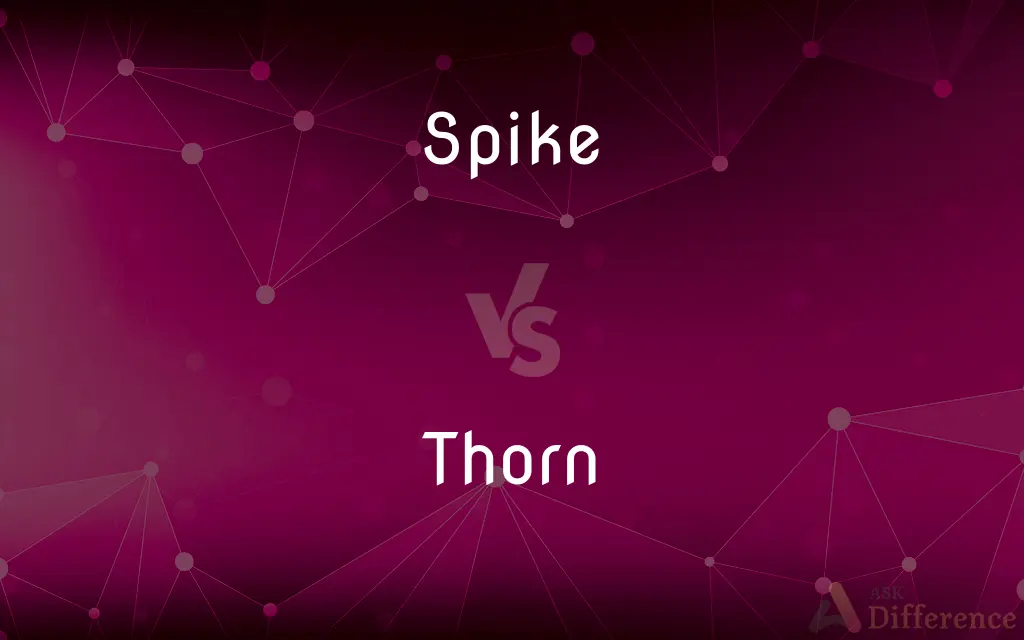Spike vs. Thorn — What's the Difference?
By Maham Liaqat & Urooj Arif — Updated on March 5, 2024
A spike is a sharp-pointed structure on plants, offering protection or support, while a thorn is a modified sharp stem or branch, deterring herbivores.

Difference Between Spike and Thorn
Table of Contents
ADVERTISEMENT
Key Differences
Spike refers to a sharp, pointed structure that can be found on some plants, serving various functions including protection against herbivores, support, and attachment. These structures are often seen in grasses and certain succulents, designed to ward off animals and aid in the plant's survival. On the other hand, a thorn is a modified branch or stem with a sharp end, specifically evolved to protect plants from being eaten by herbivores. Thorns are typically found on the stems or branches of woody plants, such as roses and hawthorns, acting as a physical deterrent to animals.
While spikes can be a part of the plant's natural development, not necessarily involving the modification of existing plant parts, thorns are explicitly modified stems, branches, or even leaves, transformed into sharp defensive tools. This fundamental difference highlights the diverse strategies plants employ for protection and survival. Whereas spikes may appear as part of the plant's overall structure without significant alteration from its normal growth pattern.
Spikes tend to be smaller and may cover larger areas of the plant, providing a general deterrent and sometimes even serving to trap moisture or aid in climbing. Thorns, whereas, are often larger, well-defined structures that focus on providing significant protection against larger herbivores, capable of inflicting more considerable damage to deter potential threats effectively.
The presence of spikes or thorns on plants often influences the type of wildlife interactions they have. Plants with spikes may deter smaller animals and insects, while those with thorns are more likely to repel larger herbivores. This distinction showcases the adaptation of plants to their specific ecological niches and the types of threats they face from their environment.
Despite their differences, both spikes and thorns share the common purpose of protecting the plant from various threats. Whether through small, numerous spikes or fewer, larger thorns, these structures play a crucial role in the survival strategy of many plant species, highlighting the remarkable adaptability of plant life.
ADVERTISEMENT
Comparison Chart
Definition
A sharp-pointed structure on plants
A modified sharp stem or branch
Function
Protection, support, attachment
Deter herbivores, physical defense
Origin
Part of natural development
Modified from stems, branches, or leaves
Size and Coverage
Smaller, may cover larger areas
Larger, well-defined structures
Interaction with Wildlife
Deters smaller animals and insects
Repels larger herbivores
Compare with Definitions
Spike
A sharp plant structure for protection.
The cactus's spikes deterred the hungry animals.
Thorn
Evolved for physical protection.
The plant's thorns evolved to protect its flowers.
Spike
Supports climbing and attachment.
The vine used its tiny spikes to climb the wall.
Thorn
A sharp deterrent against threats.
The thorns are the plant's main defense mechanism.
Spike
Serves a defensive role.
The spikes protect the plant from being eaten.
Thorn
Part of woody plants.
Thorns are common on bushes and trees in this area.
Spike
Traps moisture in arid environments.
The plant's spikes help trap dew in the desert.
Thorn
A modified branch or stem for defense.
The rose's thorns prevented it from being picked.
Spike
Part of the plant's natural development.
New spikes formed as the plant matured.
Thorn
Deters larger herbivores.
Thorns on the tree deterred the grazing deer.
Spike
Secure with spikes
Thorn
A modified branch in the form of a sharp woody structure.
Spike
Bring forth a spike or spikes;
My hyacinths and orchids are spiking now
Thorn
Any of various other sharp protuberances, such as a spine.
Thorn
Any of various shrubs, trees, or woody plants bearing such sharp structures.
Thorn
Any of various sharp protuberances on an animal.
Thorn
A sharp-pointed tip on a stem or leaf
Common Curiosities
How do thorns protect plants?
Thorns protect plants by serving as a physical deterrent to larger herbivores, preventing them from eating the plant.
Are all sharp structures on plants considered thorns?
No, not all sharp structures are thorns; some are spikes, and others may be classified as prickles or spines, depending on their origin and structure.
How do spikes differ from spines?
Spikes are generally pointed structures that can be part of the plant's leaves, stem, or flowers, while spines are modified leaves, stipules, or parts of leaves.
Do thorns grow back if removed?
Thorns, being modified stems or branches, can grow back if the plant is healthy and conditions allow for regrowth.
Can spikes and thorns be found on the same plant?
While less common, some plants may have both spikes and thorns, utilizing multiple strategies for protection and support.
Are thorns harmful to humans?
Thorns can cause injury to humans if not handled carefully, leading to punctures or scratches.
How do spikes and thorns contribute to a plant's survival?
They contribute by protecting the plant from herbivores, aiding in water retention, and sometimes supporting the plant physically.
How can you tell a spike from a thorn?
A spike is typically a part of the plant's natural growth, while a thorn is a modified stem, branch, or leaf, usually larger and more defined.
What is the main purpose of spikes on plants?
The main purpose of spikes is to provide protection against herbivores, support, and sometimes help in attachment or trapping moisture.
Do all cacti have spikes?
Most cacti have spines, which are a type of spike, evolved for protection and moisture retention.
Can the presence of spikes or thorns affect a plant's pollination?
While spikes and thorns primarily serve protective functions, they can influence pollination by deterring or attracting specific pollinators.
How do animals adapt to plants with spikes or thorns?
Some animals have evolved specific behaviors or physical adaptations to feed on plants with spikes or thorns, avoiding injury.
Are there any benefits to humans from plants with spikes or thorns?
Humans have utilized plants with spikes or thorns for various purposes, including security barriers, natural fencing, and in traditional medicine.
Can the removal of spikes or thorns harm the plant?
Removing spikes or thorns can potentially harm the plant if it leads to injury or makes the plant more susceptible to pests and diseases.
Why do some plants have thorns and others spikes?
The presence of thorns or spikes depends on the plant's evolutionary history and the specific threats it faces in its environment.
Share Your Discovery

Previous Comparison
Unit vs. Ward
Next Comparison
Effect vs. EnsueAuthor Spotlight
Written by
Maham LiaqatCo-written by
Urooj ArifUrooj is a skilled content writer at Ask Difference, known for her exceptional ability to simplify complex topics into engaging and informative content. With a passion for research and a flair for clear, concise writing, she consistently delivers articles that resonate with our diverse audience.















































